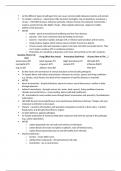(a) the different types of pathogen that can cause communicable diseases in plants and animals
To include: • bacteria – tuberculosis (TB), bacterial meningitis, ring rot (potatoes, tomatoes) •
viruses – HIV/AIDS (human), influenza (animals), Tobacco Mosaic Virus (plants) • protoctista –
malaria, potato/tomato late blight • fungi – black sigatoka (bananas), ringworm (cattle),
athlete’s foot (humans).
NOTES
o health - physical/mental/social wellbeing and free from disease,
o parasite - lives in/on and harms host by feeding on the host,
o bacteria - reproduce rapidly, damage cells or release waste products and/or toxins,
o Fungi produce hyphae which release spores (similar structure to plants),
o Viruses invade cells and reproduce copies in the host cell which eventually bursts. They
can’t respire, produce ATP or synthesise proteins,
o Protoctista are unicellular eukaryotes enter host cell and feed on the cell’s contents.
Bacteria (That’s My
Fungi (Bitch Run Away) Protoctista (Bad Man) Viruses (How In The …)
Rot)
tuberculosis (DT) black sigatoka (IT) blight (tomatoes) (IT) HIV/AIDS (DT)
meningitis (DT) ringworm (DT) malaria (DT) influenza (D&IT)
ring rot (IT) athlete’s foot (DT) TMV (DT)
(b) the means of transmission of animal and plant communicable pathogens
To include direct and indirect transmission, reference to vectors, spores and living conditions –
e.g. climate, social factors (no detail of the symptoms of specific diseases is required).
NOTES
direct transmission - droplet infections, physical contact, sexual intercourse, mother to baby
through placenta.
indirect transmission - through vectors (air, water, food, spores), living conditions (warmer
climates and social factors - overcrowding, places with bad healthcare).
TB - transmitted in overcrowded areas through direct transmission and spread by Mycobaterium
tuberculosis.
HIV/AIDS (human immunodeficiency virus/autoimmune deficiency) destroys T helper cells and
resistance to infection is decreased,
Malaria - caused by Plasmodium and spread by mosquitoes (vectors) in their saliva . It infects
hepatocytes and disrupts blood flow to organs.
(c) plant defences against pathogens
To include production of chemicals AND plant responses that limit the spread of the pathogen
(e.g. callose deposition).
NOTES
o callose deposited into cell walls and reinforced with lignin,
o callose blocks sieve tube end plates in phloem, seals off infected area,
o callose blocks plasmodesmata to seal off healthy from infected.
Chemical defences:
o tannins - create bitter taste,
o antibacterial compounds - disrupt bacterial cell walls,
o insecticides - act as neurotoxins,
, o antifungal compounds (chitinase) - break down chitin cell wall.
Chemicals Function
essential oils that have antibacterial and
terpenoids
antifungal properties
phenols antibacterial and antifungal properties
nitrogen-containing compounds creating
alkaloids bitterness, also inhibits or activates enzyme
activity
small cysteine-rich proteins that have anti-
defensins
microbial activity
chitinases (break down chitin), glucanases
hydrolytic enzymes (hydrolyse glycosidic bonds), and lysozymes
(degrade bacterial cell walls)
(d) the primary non-specific defences against pathogens in animals
Non-specific defences to include skin, blood clotting, wound repair, inflammation, expulsive
reflexes and mucous membranes (no detail of skin structure or all the steps involved in the
clotting cascade are required).
NOTES
primary non-specific defences: immediate general response
o skin acts as a physical barrier,
o mucous membranes trap microorganisms which are digested by phagocytes,
o histamines released by mast cells and cause inflammation by causing arteriole dilation
(increase b.f), capillaries become more leaky to allow more tissue fluid to form
(swelling), and this causes more fluid to enter into the lymphatic system,
o cytokines attract phagocytes to infected area,
o lymphatic system - excess tissue fluid drained here, pathogens enter the lymph nodes
(causes swelling as nodes produce phagocytes/lymphocytes),
o expulsive reflexes - coughing, vomiting, sneezing.
Blood clotting:
1. damaged tissue releases platelets,
2. platelets release thromboplastin,
3. thromboplastin and calcium ions convert prothrombin to thrombin,
4. thrombin catalyses soluble fibrinogen to insoluble fibrin,
5. fibrin forms mesh which trap platelets and blood cells,
6. this dries to form a scab; which prevents bleeding.
(e) (i) the structure and mode of action of phagocytes (ii) examination and drawing of cells
observed in blood smears
To include neutrophils and antigen-presenting cells AND the roles of cytokines, opsonins,
phagosomes and lysosomes.
NOTES
Non-specific defence - phagocytosis:
7. pathogen engulfed and phagosome formed,
8. lysosome fuse with phagosome to make phagolysosome,
9. hydrolytic enzymes in lysosome break down pathogen,




